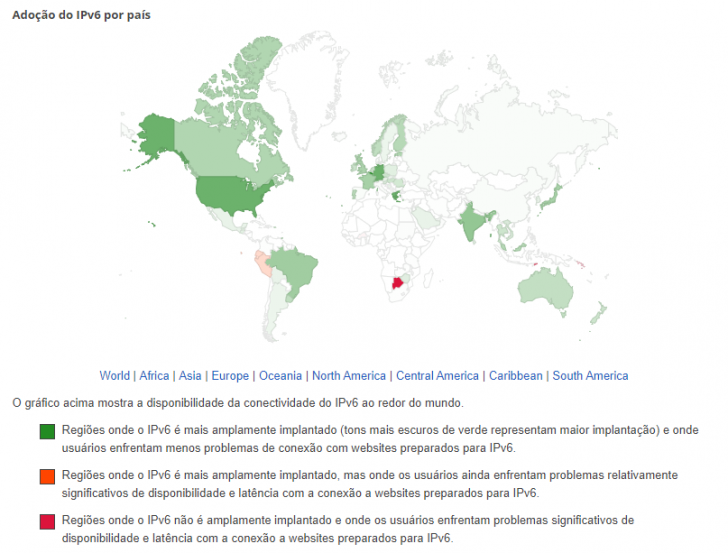

When we apply for a new identity card, we receive a unique number known as the General Registry, or RG. This number plays a crucial role in enabling legal and regulatory authorities to easily identify us.
In the digital realm, this is not significantly different.
In the realm of computers, the IP serves as a distinctive identifier for each machine on a network, whether local or public, ensuring that no two computers share the same identifier.
For optimal utilization of these addresses, the domain format, like “everything above.com.br,” is typically employed to make the numerical address more user-friendly.
Each domain address is translated into an IP address using the Domain Name System (DNS) through a process known as “name resolution.”
Consider the number of unnecessary IPs around the globe.
The increase in technology necessitated a transformation in the IP definition for devices. This post will discuss IPv6, its advantages, and the disparities between IPv6 and the widely used IPv4 version.
Protocol’s new generation
Why did the IP, which is a unique numerical identifier, need to progress?
Will each computer connected to the network be given a distinct number?
Sure.
This is the primary issue currently encountered.
The IP address in IPv4 is a 32-bit number made up of four bytes written in decimal format, like “192.168.1.2”, commonly encountered by developers and network technicians.
IPv4 has a limitation of 4.294.967.296 billion IP addresses, leading to the current crisis of unique number exhaustion.
Something reminiscent happened on YouTube three years ago when the song “Gangnam Style” by South Korean singer Psy went viral, overwhelming the platform’s view counting algorithm, originally designed with 32 bits.
IPv4 address exhaustion happens primarily because, at the time these protocols were developed, the internet was not meant for commercial use.
How can more IP addresses be made available on a rapidly expanding internet, as internet providers and regulatory agencies are now working towards this goal?
What are the benefits of utilizing IPv6?
The conversation on the development of the IP protocol is dated, as early as 1993 there were concerns that the internet address space could be depleted within 2 to 3 years.
On June 6, 2012, the new version of IP, IPv6, was officially launched after previous unsuccessful versions were introduced. This release was the outcome of the IETF’s efforts to develop the “next generation of IP” (IPng: Internet Protocol next generation).
This innovation was developed not just to address address scarcity issues, but also to provide additional services and advantages not found in IPv4 or not fully utilized.
IPv6 consists of a 128-bit address, which is four times larger than the address in IPv4’s latest version.
IPv6 addresses are typically expressed as eight groups of four hexadecimal digits each.
Below is an illustration:
2001:0db8:85a3:08d3:1319:8a2e:0370:7344
Users of any type can access a significantly higher number of IPs from their providers, enabling them to create around 65,000 networks, each with 2^64 addresses (18 quintillion). The total addressing capacity is 2^128.
This amount is equivalent to about 79 octillion times the quantity of IPv4 addresses available, totaling 340 undecillion!
It is an address that does not exist anymore.
What benefit is there in using IPv6, even though this update mainly aims to enhance internet address capacity?
This matter is intriguing and may lead to some misunderstanding.
The move to IPv6 is taking longer than expected, with Brazil being the only country that stands out in adoption rates, reaching 20% adoption according to Google.
Google has included a live update on the adoption of IPv6, available for viewing on the map provided.


Low adoption rates globally created challenges for access providers who ran out of available IPv4 addresses to connect new users to the internet. Consequently, they began implementing the newer version, but the uptake among accessed websites remained minimal.
Access providers had to use a technology called CGNAT to ensure access to websites that did not support it, by allowing multiple clients to share the same IPv4 address.
CGNAT can reduce website access speed due to sharing, but using IPv6 can improve performance and quality perception depending on the provider’s management.
Therefore, by adopting IPv6 now, the main advantage is enhancing the perception of performance and speed for users accessing your site, besides ensuring address availability. This can be particularly beneficial for businesses relying on high-quality connections.
What is the present situation of IPv4?
The NIC.br Center suggests that in the near future, the transition from IPv4 to IPv6 will continue, eventually leading to the complete abandonment of IPv4. Both protocols will coexist for some time in the short term.
The change is expected to happen slowly according to the forecast. See the table below for the status of each region where IPs are allocated.
| Region | Status |
| Central Stock (IANA) | Depleted in 2011 |
| Asia/Pacific (APINIC) | Depleted in 2011 |
| Europe (RIPE) | Depleted in 2012 |
| North America (ARIN) | Depleted in 2015 |
| Latin America (LACNIC) | Depleted in 2014 |
| Africa (AFRINIC) | Expected to be Depleted in 2019 |
Sources can be found at https://www.google.com/intl/en-BR/ipv6/ and http://ipv6.nic.br/post/address/.
For further details on IPv6 adoption in Brazil, visit the website established by NIC.br to access relevant information: http://ipv6.nic.br/
Discover other benefits
Users who have already implemented IPv6 on their hosting server can benefit from improved performance and other long-term advantages.
- Global reach and scalability are facilitated by a broad address space.
- Header format made simpler for optimizing package delivery.
- Efficient routing is achieved through a hierarchical network architecture.
- Current routing protocols are being assisted.
- Self-configuration services;
- IPSec is implemented in its original form.
- Increase in the quantity of multicast addresses.
- Quality of service implementations.
How the Adoption of IPv6 Functions
Each hosting provider has its own approach to implementing IPv6 with its clients. We suggest verifying the availability and deployment costs with your hosting service to assess the cost-effectiveness for your needs.
To implement IPv6, typically you would need to access a dashboard or service to request it and then configure the DNS with the AAAA records provided by your hosting provider. If you encounter any challenges, seeking assistance from a technician or support team familiar with the process is recommended for a smooth setup.
Understanding the future of the internet with IPv6.
Adopting IPv6 is necessary due to the exhaustion of version 4, but it is not widely used because many believe there is no immediate need for it.
The key consideration is determining if implementing IPv6 is beneficial for your business, particularly in enhancing performance and availability of your online service. Consequently, the main aspects to assess in the future regarding IPv6 are:
- Performance of a website, blog, e-commerce platform, or online software.
- Transition with hosting providers and services concerning IPv4 depletion.
- Disadvantage compared to those who have already adopted.
Conclusion
We discussed the advantages of using IPv6 compared to its predecessor, IPv4, in the previous post. Thank you for reading!
Feel free to share with your coworkers and friends! If you have any unanswered questions, please leave a comment, and we’ll be happy to reply.
Published on 05/10/2017 with updates made on 20/04/2018.
Concepts are labeled as tags.
